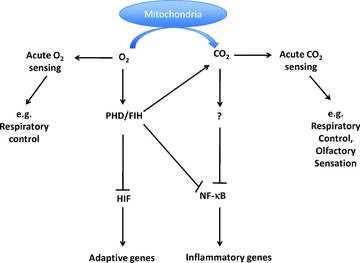Regulation of gene expression by carbon dioxide - PubMed (original) (raw)
Review
Regulation of gene expression by carbon dioxide
Cormac T Taylor et al. J Physiol. 2011.
Abstract
Carbon dioxide (CO(2)) is a physiological gas found at low levels in the atmosphere and produced in cells during the process of aerobic respiration. Consequently, the levels of CO(2) within tissues are usually significantly higher than those found externally. Shifts in tissue levels of CO(2) (leading to either hypercapnia or hypocapnia) are associated with a number of pathophysiological conditions in humans and can occur naturally in niche habitats such as those of burrowing animals. Clinical studies have indicated that such altered CO(2) levels can impact upon disease progression. Recent advances in our understanding of the biology of CO(2) has shown that like other physiological gases such as molecular oxygen (O(2)) and nitric oxide (NO), CO(2) levels can be sensed by cells resulting in the initiation of physiological and pathophysiological responses. Acute CO(2) sensing in neurons and peripheral and central chemoreceptors is important in rapidly activated responses including olfactory signalling, taste sensation and cardiorespiratory control. Furthermore, a role for CO(2) in the regulation of gene transcription has recently been identified with exposure of cells and model organisms to high CO(2) leading to suppression of genes involved in the regulation of innate immunity and inflammation. This latter, transcriptional regulatory role for CO(2), has been largely attributed to altered activity of the NF-B family of transcription factors. Here, we review our evolving understanding of how CO(2) impacts upon gene transcription.
Figures
Figure 1. Transcriptional regulation by oxygen and carbon dioxide
Metazoan cells have evolved to be capable of sensing levels of physiological gasses in the microenvironment through highly conserved pathways in the control of gene expression. Acute O2 and CO2 sensing leads to neuronally mediated changes in processes such as respiratory control and olfactory sensation, respectively. Molecular oxygen (O2) is sensed by prolyl and aspariginyl hydroxylases, which confer oxygen-dependent instability upon the HIF transcription factor. Activation of this pathway in hypoxia leads to the expression of adaptive genes. The sensor for regulation of NF-κB-dependent gene expression in response to changes in CO2 has yet to be defined. However, elevated CO2 leads to repression of the NF-κB pathway and decreased levels of genes which promote innate immunity and inflammation.
Similar articles
- Peripheral chemoreceptors determine the respiratory sensitivity of central chemoreceptors to CO2 : role of carotid body CO2.
Smith CA, Blain GM, Henderson KS, Dempsey JA. Smith CA, et al. J Physiol. 2015 Sep 15;593(18):4225-43. doi: 10.1113/JP270114. Epub 2015 Aug 16. J Physiol. 2015. PMID: 26171601 Free PMC article. - The peripheral-chemoreceptor threshold to carbon dioxide in man.
Duffin J, McAvoy GV. Duffin J, et al. J Physiol. 1988 Dec;406:15-26. doi: 10.1113/jphysiol.1988.sp017365. J Physiol. 1988. PMID: 3151077 Free PMC article. - Respiratory gases and the regulation of transcription.
Cummins EP, Keogh CE. Cummins EP, et al. Exp Physiol. 2016 Aug 1;101(8):986-1002. doi: 10.1113/EP085715. Exp Physiol. 2016. PMID: 27474261 Review. - Sensing and transfer of respiratory gases at the fish gill.
Perry SF, Gilmour KM. Perry SF, et al. J Exp Zool. 2002 Aug 1;293(3):249-63. doi: 10.1002/jez.10129. J Exp Zool. 2002. PMID: 12115900 Review. - The chemical control of respiration.
Cherniack NS, Longobardo GS. Cherniack NS, et al. Ann Biomed Eng. 1981;9(5-6):395-407. doi: 10.1007/BF02364759. Ann Biomed Eng. 1981. PMID: 6814307 Review. No abstract available.
Cited by
- The clinical potential of exhaled breath analysis for diabetes mellitus.
Minh Tdo C, Blake DR, Galassetti PR. Minh Tdo C, et al. Diabetes Res Clin Pract. 2012 Aug;97(2):195-205. doi: 10.1016/j.diabres.2012.02.006. Epub 2012 Mar 10. Diabetes Res Clin Pract. 2012. PMID: 22410396 Free PMC article. Review. - Alveolar macrophages initiate the systemic microvascular inflammatory response to alveolar hypoxia.
Chao J, Wood JG, Gonzalez NC. Chao J, et al. Respir Physiol Neurobiol. 2011 Sep 30;178(3):439-48. doi: 10.1016/j.resp.2011.03.008. Epub 2011 Mar 21. Respir Physiol Neurobiol. 2011. PMID: 21402178 Free PMC article. Review. - Systemic inflammation impairs respiratory chemoreflexes and plasticity.
Huxtable AG, Vinit S, Windelborn JA, Crader SM, Guenther CH, Watters JJ, Mitchell GS. Huxtable AG, et al. Respir Physiol Neurobiol. 2011 Sep 30;178(3):482-9. doi: 10.1016/j.resp.2011.06.017. Epub 2011 Jun 25. Respir Physiol Neurobiol. 2011. PMID: 21729770 Free PMC article. Review. - Elevated carbon dioxide blunts mammalian cAMP signaling dependent on inositol 1,4,5-triphosphate receptor-mediated Ca2+ release.
Cook ZC, Gray MA, Cann MJ. Cook ZC, et al. J Biol Chem. 2012 Jul 27;287(31):26291-301. doi: 10.1074/jbc.M112.349191. Epub 2012 May 31. J Biol Chem. 2012. PMID: 22654111 Free PMC article. - Identification of a novel gene for diabetic traits in rats, mice, and humans.
Tsaih SW, Holl K, Jia S, Kaldunski M, Tschannen M, He H, Andrae JW, Li SH, Stoddard A, Wiederhold A, Parrington J, Ruas da Silva M, Galione A, Meigs J; Meta-Analyses of Glucose and Insulin-Related Traits Consortium (MAGIC) Investigators; Hoffmann RG, Simpson P, Jacob H, Hessner M, Solberg Woods LC. Tsaih SW, et al. Genetics. 2014 Sep;198(1):17-29. doi: 10.1534/genetics.114.162982. Genetics. 2014. PMID: 25236446 Free PMC article.
References
- Amato MB, Barbas CS, Medeiros DM, Magaldi RB, Schettino GP, Lorenzi-Filho G, Kairalla RA, Deheinzelin D, Munoz C, Oliveira R, Takagaki TY, Carvalho CR. Effect of a protective-ventilation strategy on mortality in the acute respiratory distress syndrome. N Engl J Med. 1998;338:347–354. - PubMed
- ARDSnet. Ventilation with lower tidal volumes as compared with traditional tidal volumes for acute lung injury and the acute respiratory distress syndrome. The Acute Respiratory Distress Syndrome Network. N Engl J Med. 2000;342:1301–1308. - PubMed
- Berner RA. The long-term carbon cycle, fossil fuels and atmospheric composition. Nature. 2003;426:323–326. - PubMed
Publication types
MeSH terms
Substances
LinkOut - more resources
Full Text Sources
